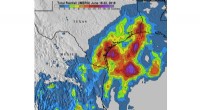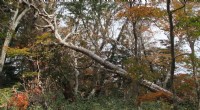
Wetenschap
Wat is de toekomst van de bossen in de staat Washington? Bedreigde murrelet zeevogel gevangen in gevecht
Niemand is blij met de laatste plannen voor de bosgebieden van Washington.
Niet de milieuactivisten.
"Onmoedig, " zei Peter Goldman, een advocaat bij het Washington Forest Law Center.
Niet de houtindustrieën, die banenverlies voorspellen.
Niet de lokale ambtenaren, wiens economieën en budgetten afhankelijk zijn van houtinkomsten.
"Dubbele klap, " zei Rod Fleck, De stadsadvocaat van Forks.
Gevangen in het rumoer is de gemarmerde murrelet, een zippy, robin-sized vogel die tijd doorbrengt in kustwateren en nesten in de bossen van Washington.
Welke ambtenaren ook kiezen voor het bos, de zeevogels zijn waarschijnlijk gepland voor ten minste een decennium van achteruitgang, volgens populatiemodellen in het definitieve plan voor hun instandhouding. Oceaan omstandigheden, beschikbaarheid van prooien, menselijke activiteit en verlies van leefgebied zijn factoren die volgens wetenschappers een rol spelen.
De gemarmerde zeekoet heeft dikke boomtakken nodig in volgroeid bos om zijn jongen groot te brengen.
Decennia van houtkap en ontwikkeling op federale, staats- en particuliere gronden hebben de vogel achtergelaten met verspreide stukken eersteklas Washington-bos dat geschikt is om te nestelen. Wetenschappers zeggen dat ze meer nodig hebben.
Maar hun leefgebied is ook bij uitstek geschikt voor houtkap. En in veel plattelandsgemeenschappen, inkomsten uit houtverkoop helpen lokale instellingen te ondersteunen, zoals brandgebieden, de gemarmerde zeekoe het middelpunt van een decennialange impasse over waar en hoeveel houtkap plaatsvindt in door de staat beheerde bossen.
Na de staat in 1889, de federale regering gaf Washington meer dan 3 miljoen hectare om enkele openbare instellingen financieel te ondersteunen, zoals scholen en universiteiten.
Het ministerie van Natuurlijke Hulpbronnen beheert de resterende trustgrond. Opbrengsten van houtverkoop aan houtkapbedrijven leveren vandaag nog steeds wat K-12 en universitaire financiering op.
DNR beheert ook trustland dat provincies hebben ontvangen in belastingafschermingen uit het tijdperk van de depressie. Provincies en kleinere belastingdiensten zoals lokale scholen, brand- of bibliotheekdistricten ontvangen houtinkomsten van deze gronden.
In delen van het landelijke Washington, houtverkoop helpt om de lichten aan te houden bij deze instellingen. DNR brengt zelf haar begroting in evenwicht met de houtopbrengsten.
Critici zoals Goldman beweren dat het financieren van kerntaken van de overheid met hout een '19e-eeuwse mentaliteit' is.
Maar het bureau gelooft, na rechterlijke beslissingen en juridisch advies van de procureur-generaal, dat het wettelijk verplicht is om de inkomsten te maximaliseren.
DNR moet ook de staats- en federale wetten volgen, zoals de Endangered Species Act, waarin de gemarmerde murrelet als bedreigd wordt vermeld.
Deze concurrerende belangen zorgen ervoor dat het agentschap een afweging maakt tussen houtbelangen en milieuoverwegingen.
In december, vier van de zes leden van de Raad voor Natuurlijke Hulpbronnen keurden een instandhoudingsstrategie voor gemarmerde murrelets goed en verlaagden het niveau van duurzame houtoogst op staatsgronden voor de komende 10 jaar.
De beslissing gaf duidelijkheid voor het herstel van de vogel, na 22 jaar onder een interim-plan.
Het plan voorziet in nog eens 37, 000 acres van DNR land in staat van instandhouding voor de murrelet.
Het plan van het bureau is gebaseerd op jonge bomen in nieuw beschermde gebieden om uit te groeien tot een leefgebied voor de vogel. Naarmate ze groeien, DNR zal geleidelijk enkele gebieden met volwassen bomen - de huidige habitat van de zeekoe - vrijgeven om te worden geregistreerd.
Gebieden waar nu murrelets leven, zouden buffers hebben om de habitat te beschermen. Rotsstralen, nieuwbouw en wegenbouw zouden niet zijn toegestaan in de buurt van het leefgebied van de murrelet, met enkele uitzonderingen.
Het plan wijst ook 20 bijzondere leefgebieden aan, die het agentschap in staat zou stellen om "instandhouding in blokken habitat" te concentreren van wat nu een "verstrooiing, " zei Andrew Hayes, Divisiemanager bosbouw van DNR.
Hayes zei dat de gemarmerde murrelet 272 zal hebben. 000 acres geschikte habitat in 50 jaar, zo'n 65, 000 hectare meer dan nu. (Goldman beweert dat de verhoging van het areaal in wezen een wasbeurt is, omdat de kwaliteit van de habitat van het plan in de loop van de tijd varieert.) Het plan maakt ook meer dan 150, 000 acres for logging, Hayes said.
A representative of Gov. Jay Inslee voted against the plan, saying the governor felt it was not protective enough in the face of climate change.
Clallam County Commissioner Bill Peach opposed it also, warning the decision to lower harvest targets could stress timber communities and DNR's budget.
Public Lands Commissioner Hilary Franz said the approval paved the way for "more significant challenges in front of us, " including adaptation to climate change as Washington's population grows and natural resources yield less.
From nearly every angle, the plan faces criticism.
"It divides the baby right down the middle, "Goldman zei, representing several environmental groups. "They feel they made a legally and politically safe position."
Goldman is disappointed that DNR will open 38, 000 acres of current marbled murrelet habitat to logging, believes the agency sought only minimum protection under the ESA and lacked the "vision" to ask for more.
"This is for a species declining at 4% a year and has all kinds of threats to forests and oceans, inclusief klimaatverandering, " Goldman said.
Paula Swedeen, of Conservation Northwest, pointed out that DNR's modeling projects murrelet populations will decline for several decades under the plan and in 50 years have a population lower than it is today.
In de tussentijd, the timber industry promises job losses.
The board set a sustainable harvest figure that averages 465 million board feet each year, 85 million less than the previous decade's mark, a volume DNR did not ultimately supply. Hayes said sustainable harvest levels are expected to drop over the next five decades.
"You just can't pull that much volume out of the marketplace without having some kind of economic impacts, " said Matt Comisky, Washington state manager for the American Forest Resource Council.
For timber communities, state harvest reductions cut several ways.
Long term, Clallam County Comissioner Randy Johnson said he expects an economic hit as loggers, truck haulers and millers expect less timber coming off state managed lands.
The reductions look particularly stark in the county's timber-dependent west side. About one-third of Forks' economy is tied to natural resources, said Fleck, the city attorney and planner for the town, which has a 26% poverty rate, according to U.S. census estimates.
Each million board feet harvested is directly tied to about eight jobs, according to DNR analysis.
"It's going to be hundreds of jobs in places like Concrete, Forks, Cathlamet, " Fleck said.
Fleck fears that complexities in DNR's plan, like specialty habitat areas and phasing habitat in and out over time, could cause disproportionate short-term effects in certain local taxing districts where mature forest is kept off limits to logging.
"It's a whammy to revenue for essential government functions:Schools, ziekenhuizen, havens, bibliotheken, ambulances, " Fleck said.
Frustration was not unexpected, Franz said. There are lousier fates.
"The worst thing that could happen is us ending up in court, " Franz said. "Our job was to comply with the Endangered Species Act, but not go so far that we violate our fiduciary responsibility" to counties and schools. (The matter might end up in court regardless. Skagit County's commissioners have approved a resolution authorizing the county prosecutor to bring legal action against DNR over its sustainable harvest calculation.)
None of the options DNR considered would halt the marbled murrelets' near-term decline, Franz noted. Western Washington's forest, on the whole, is not old enough. The trees simply need time to grow for the birds to recover, ze zei.
In Franz's eyes, conservation of the marbled murrelet represents a small portion of the bigger issue:The falling sustainable timber harvest and what that means for rural communities. She convened a "solutions table" to soften impacts and consider new economic opportunities on rural lands.
When the board approved the murrelet plan, state Superintendent Chris Reykdal called for a transformation of how forests and timber funds are used as the climate changes.
"This is not the future of school construction. It just isn't. This money would be better used to protect species, to protect habitat and to take care of the industries and impacted counties, " he said. "The state of Washington needs something else."
As rural communities look toward declining harvest, Fleck fears rural transformation won't come soon enough.
©2019 The Seattle Times
Gedistribueerd door Tribune Content Agency, LLC.
 Wetenschappers ontwikkelen methode om de porositeit van transparante materialen te berekenen
Wetenschappers ontwikkelen methode om de porositeit van transparante materialen te berekenen Gehydrateerde eutectische elektrolyten helpen de prestaties van waterige zinkbatterijen te verbeteren
Gehydrateerde eutectische elektrolyten helpen de prestaties van waterige zinkbatterijen te verbeteren Op de natuur geïnspireerde materialen kunnen worden gebruikt in toepassingen variërend van tunneling tot ruimtevaart
Op de natuur geïnspireerde materialen kunnen worden gebruikt in toepassingen variërend van tunneling tot ruimtevaart Factoren die de pH van water in Wetlands
Factoren die de pH van water in Wetlands Nieuwe spin-overgang metaal-organische raamwerken gebruiken veel minder energie om vast te leggen, hergebruik koolmonoxide
Nieuwe spin-overgang metaal-organische raamwerken gebruiken veel minder energie om vast te leggen, hergebruik koolmonoxide
Hoofdlijnen
- Nieuwe gen-editor gebruikt om ziekte in embryo's op te lossen:studie
- Energiebesparende LED's stimuleren wereldwijd lichtvervuiling
- Wat zijn de verschillen tussen een CZS en een PNS?
- Tumorsuppressorgenen: wat is het?
- Soorten organellen
- Op de vleugels van Lepidoptera
- Wat is Ribonucleic Acid?
- Onderzoekers ontdekken dat twee verschillende ecologische mechanismen veerkracht kunnen bieden tegen invasieve soorten
- Virussen bestrijden:codebrekers worden codeschrijvers
- Regen op Groenlandse ijskap signaleert risico op klimaatverandering

- Enkele verrassingen over de afbraak van microplastics in onze oceanen

- IMERG onderzoekt overstromingen in het zuiden van Texas door tropische verstoringen

- Wetenschap zegt:waarom biodiversiteit belangrijk voor je is

- Studie van boomringen biedt meer bewijs van poolwaartse migratie van tropische stormen

 Hoe de Ionische sterkte van een Solution
Hoe de Ionische sterkte van een Solution Sony gaat AI-geïnfuseerde robotpups vrijgeven in de VS
Sony gaat AI-geïnfuseerde robotpups vrijgeven in de VS Kaarten van gevallen koninkrijk werpen licht op Atlantische slavenhandel
Kaarten van gevallen koninkrijk werpen licht op Atlantische slavenhandel Online tool versnelt evolutieonderwijs
Online tool versnelt evolutieonderwijs Eenvoudige hydraulische projecten voor Science
Eenvoudige hydraulische projecten voor Science Bevindingen van NASA's Juno updaten Jupiter watermysterie
Bevindingen van NASA's Juno updaten Jupiter watermysterie Nieuwsgierige grote witte haai speelt met camera
Nieuwsgierige grote witte haai speelt met camera Hoe temperatuur en vochtigheid samenhangen
Hoe temperatuur en vochtigheid samenhangen
- Elektronica
- Biologie
- Zonsverduistering
- Wiskunde
- French | Italian | Spanish | Portuguese | Swedish | German | Dutch | Danish | Norway |

-
Wetenschap © https://nl.scienceaq.com

